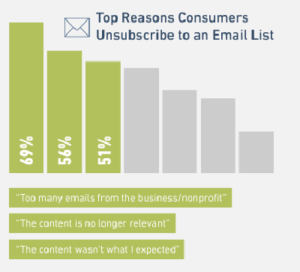The way you handle email unsubscribes for your marketing emails is more important than it looks.
It’s not a time to make things difficult for the people who want to leave your list, or to just dismiss them without a second thought.
There’s actually a huge reason to make unsubscribing from your list easy, if not even pleasant: Spam complaints.
If people can’t find the unsubscribe link quickly and easily in your marketing emails, they will mark your message as spam. This is different for transactional emails, because those don’t require an unsubscribe link by law. Transactional emails also tend to get far fewer unsubscribe requests than marketing messages. But for this post, we’re focused mainly on marketing emails.
Enough spam complaints from any kind of email and your deliverability rates will begin to drop. In fact, if your marketing emails’ spam complaints are high (like over .07%), the first thing to look at is your unsubscribe process.
There’s another, nicer reason to handle unsubscribes carefully: You might be able to save the subscriber. People may unsubscribe because they don’t need or want your emails, but it’s why they don’t need or want your emails that we’re interested in. The why holds the key for:
• How to retain some of the subscribers who initiate the unsubscribe process
• Let other subscribers choose a different way to stay in touch (like social media)
• Let the remainder go without annoying them
Why People Unsubscribe
These are the three most common reasons people unsubscribe from emails according to research from Constant Contact.

Other reasons people unsubscribe include:
– They can’t read your emails on their mobile device
– They get too many emails in general
– Email isn’t the way they want to hear from you anymore
– They don’t remember who you are
– They want to change their email address
Each one of these reasons holds an important piece of information about how to turn the unsubscribe process from a quick, awkward parting to an opportunity to actually improve the relationship with your subscriber. So let’s walk through every opportunity you’ve got to turn your subscribers’ unsubscribe process around.
To give you an idea of how many email marketing programs comply with the best practices we’ll talk about, take a look at this table from the Online Trust Alliance’s 2014 Email Unsub Best Practices and Audit report. This report is based on the unsubscribe processes of 200 major retailers.

Retain your subscribers
1) Give them a way to change their email address.
Many email users have three or even four email accounts. They often move their subscriptions around, so when that’s happening, make it easy for them. Here’s an example of what an email address change form might look like. Notice the “new email address” field in the gray box:

2) Let them “opt-down”.
This refers to letting subscribers control how often they hear from you. So if you’re sending daily emails, offer them the option of getting emails once a week, or even once a month.

Some email newsletters give you a way to opt-down without even initiating the unsubscribe process, like this footer with a link for “Manage Preferences”:

3) Give them the option of re-subscribing even after they’ve unsubscribed.
This will be a little too pushy for some marketers, but if you retain even 5% of subscribers who would have otherwise opted out, it might be worth it.
4) Remind them of the benefits of staying on your list.
Of course, there have to be compelling benefits to staying on your list. This email from a pet supply retailer reminds people they’ll get weekly coupons only available to email subscribers… if they stay on the list.

5) Give them the option of going on “an email fast” or an “email vacation.”
This is similar to letting people opt-down, but with a twist. Here you give them the option to take a month off from receiving emails, or maybe even three months off.
6) Suggest they follow you on social media.
Marine Depot almost has this tactic down. This is the page I saw after I unsubscribed, where their “follow us on social media” pitch should have been.

But instead of suggesting I follow them on social media on that confirmation page, they sent me an annoying email unsubscribe confirmation email. The unsubscribe page is where they put their links to their social media platforms. If they had included this information in the unsubscribe confirmation page, I might have followed them on Facebook.

Here’s an example of an almost perfect unsubscribe confirmation page. Why is it so good? It’s super-easy to read, it confirms the unsubscribe, and it pitches their social media channels. It even offers me a chance to resubscribe.

Don’t annoy them
7) Make the unsubscribe link easy to find.
First thing: Use the word “Unsubscribe” as the anchor text of your unsubscribe link. Anything else is confusing.
Second thing: Make the link prominent. Google’s Gmail just did this for us by adding an unsubscribe link near the top of every email a Gmail user sees. But only 14.2% of email accounts use Gmail (according to a 2014 YesMail Interactive study). Given that 85.8% subscribers won’t see Gmail’s top unsubscribe link, consider adding your own unsubscribe link, like this:

Adding the top link will make it easier for them to unsubscribe, but remember: You don’t want to clutch on to subscribers who don’t want to be on your list. It just builds bad will. It also makes for poor engagement rates, and as your engagement rates fall off, your overall deliverability rates start to go downhill. So stay off that slippery slope.
Here’s an example of an unsubscribe link that is fairly hard to find. It’s certainly not impossible to find, but it takes long enough to annoy the average user. Notice how much easier it would be to recognize the unsubscribe link if the merchant had just used “unsubscribe” in the anchor text.

8) Always add an unsubscribe link at the bottom of your emails.
Bonus: Remind people how they got on your list in the first place. Here’s how marketer Ana Hoffman reminds subscribers how they got on her list:

9) Don’t make them fill out a survey before they can unsubscribe.
If they’re trying to unsubscribe, you’ve done too much marketing already. Don’t drag them through anymore.
10) Process unsubscribes immediately.
CASL (https://www.smtp2go.com/blog/canadian-anti-spam-law/) and CAN SPAM give you up to ten days to process unsubscribes, but most people expect to be removed instantly. If you keep mailing them after they’ve unsubscribed, they just might click that spam button.
Political campaigns are notoriously bad about this. You unsubscribe, and yet they continue to send you emails for two more weeks. Don’t do this. Once people have asked to go, let them go.
11) Don’t make people log in to unsubscribe.
Forcing people to log in is against CAN-SPAM law, so if you’re sending to American subscribers, making people log in is actually illegal.
12) Don’t send them an unsubscribe confirmation email.
It’s just annoying. Instead, give your ex-subscriber a clear message on the email unsubscribe confirmation page. People should not have to wonder if they’ve been unsubscribed. Also, don’t hide the unsubscribe message in tiny type.
Something like the image below is good. This message is the only thing you see on the unsubscribe confirmation page of a major retailer:

Remember: Half of the people who unsubscribe from your list will be on mobile devices. In addition to navigating your unsubscribe page, they may be walking down the street, talking to someone else, or even driving. Make your unsubscribe process simple enough to accommodate their fractured attention.
13) Bring them to a branded unsubscribe page.
The only problem with the example above (the green confirmation message) is the retailer did not include their logo on the page. It’s better if you include your logo so the subscriber knows for sure who’s list they’ve unsubscribed from. The principle behind this is the same as other best practices outlined here: Don’t make people guess. Besides, it’s one last chance to get a brand impression in.
Good news for SMTP2GO users: We’ve got this covered. You can add your logo to your unsubscribe confirmation page, if you choose to use SMTP2GO’s built-in unsubscribe functionality.
14) Offer your subscribers the ability to unsubscribe from all commercial messages you send, not just emails.
That means text messages, direct mail, and phone calls.
15) The unsubscribe links in your emails should work for at least 60 days after the email has been sent.
It’s surprising, but many emails have unsubscribe links that stop working after a period of time. This may benefit the marketer, but it irritates subscribers no end. Not only that, but it’s illegal: CASL requires unsubscribe links to work for 60 days after sending. CAN SPAM requires they work for 30 days.





